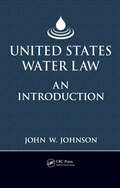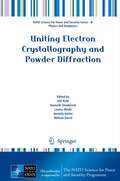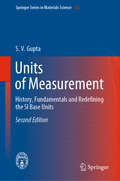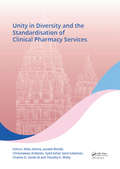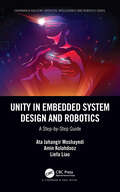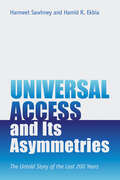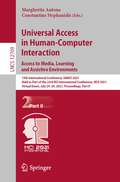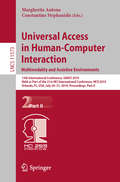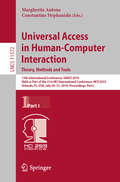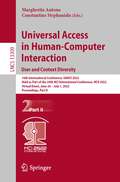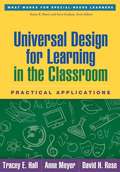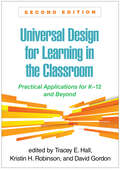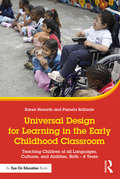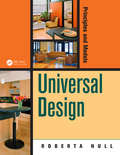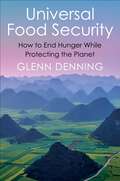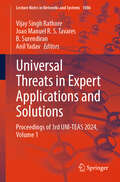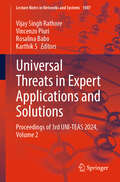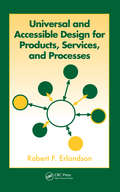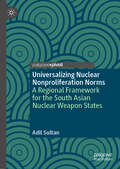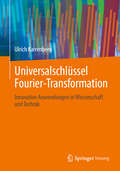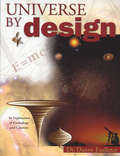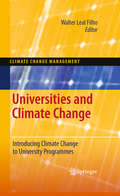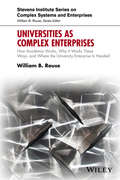- Table View
- List View
United States Water Law: An Introduction
by John W. JohnsonA Vital Explanation of Water Law and PolicyBecause demand for and access to quality water far exceeds the current supply, it is increasingly critical to understand the state and federal laws and policies that govern water rights. From farming, fishing, and biology to manufacturing, mine operation, and public water supply, water regulation affects a
Uniting Electron Crystallography and Powder Diffraction
by Anatoly Avilov Kenneth Shankland Louisa Meshi Ute Kolb William I.F DavidThe polycrystalline and nanocrystalline states play an increasingly important role in exploiting the properties of materials, encompassing applications as diverse as pharmaceuticals, catalysts, solar cells and energy storage. A knowledge of the three-dimensional atomic and molecular structure of materials is essential for understanding and controlling their properties, yet traditional single-crystal X-ray diffraction methods lose their power when only polycrystalline and nanocrystalline samples are available. It is here that powder diffraction and single-crystal electron diffraction techniques take over, substantially extending the range of applicability of the crystallographic principles of structure determination. This volume, a collection of teaching contributions presented at the Crystallographic Course in Erice in 2011, clearly describes the fundamentals and the state-of-the-art of powder diffraction and electron diffraction methods in materials characterisation, encompassing a diverse range of disciplines and materials stretching from archeometry to zeolites. As such, it is a comprehensive and valuable resource for those wishing to gain an understanding of the broad applicability of these two rapidly developing fields.
Units of Measurement: History, Fundamentals and Redefining the SI Base Units (Springer Series in Materials Science #122)
by S. V. GuptaThis book delivers a comprehensive overview of units of measurement. Beginning with a historical look at metrology in Ancient India, the book explains fundamental concepts in metrology such as basic, derived and dimensionless quantities, and introduces the concept of quantity calculus. It discusses and critically examines various three and four-dimensional systems of units used both presently and in the past, while explaining why only four base units are needed for a system of measurement. It discusses the Metre Convention as well as the creation of the International Bureau of Weights and Measures, and gives a detailed look at the evolution of the current SI base units of time, length, mass, electric current, temperature, intensity of illumination and substance.This updated second edition is extended with timely new chapters discussing past efforts to redefine the SI base units as well as the most recent 2019 redefinitions based entirely on the speed of light and other fundamental physical constants. Additionally, it provides biographical presentations of many of the historical figures behind commonly used units of measurements, such as Newton, Joule and Ohm, With its accessible and comprehensive treatment of the field, together with its unique presentation of the underlying history, this book is well suited to any student and researcher interested in the practical and historical aspects of the field of metrology.
Unity Game Audio Implementation: A Practical Guide for Beginners
by Andrew CogganUnity Game Audio Implementation offers a unique, practical, project-based approach to learning about aspects of Interactive Game Audio for those who have never used a game engine before and don’t want to learn computer programming right now. The book offers insight into the skills needed to design game-ready sounds in current Digital Audio Workstation (DAW) and shows how to implement these sounds within the Unity game engine. The reader will also learn about interactive music and how to set this up to respond to a variety of events in the game, with the option of adding in their own story and dialogue. All the information is presented in a practical working context from an established Game Audio Sound Designer with AAA games experience. The chapters are accompanied by several game levels teaching all about the techniques and theories before offering instructive steps for how to put them into action. After completing the practical tasks in this book, not only will the reader create an interactive soundscape for a multilevel playable game featuring all their own audio, they will also receive tips on how to use their finished project in support of an application for Video Game Sound Designer jobs.
Unity in Diversity and the Standardisation of Clinical Pharmacy Services: Proceedings of the 17th Asian Conference on Clinical Pharmacy (ACCP 2017), July 28-30, 2017, Yogyakarta, Indonesia
by Elida Zairina, Junaidi Khotib, Chrismawan Ardianto, Syed Azhar Syed Sulaiman, Charles D. Sands III and Timothy E. WeltyUnity in Diversity and the Standardisation of Clinical Pharmacy Services represents the proceedings of the 17th Asian Conference on Clinical Pharmacy (ACCP 2017), held 28—30 July 2017 in Yogyakarta, Indonesia. The primary aim of ACCP 2017 was to bring together experts from all fields of clinical pharmacy to facilitate the discussion and exchange of research ideas and results. The conference provided a forum for the dissemination of knowledge and exchange of experiences. As such, it brought together clinical pharmacy scholars, pharmacy practitioners, policy makers and stakeholders from all areas of pharmacy society and all regions of the world to share their research, knowledge, experiences, concepts, examples of good practice, and critical analysis with their international peers. This year also marks the celebration of 20 years of ACCP. Central themes of the conference and contributed papers were Clinical Pharmacy, Social and Administrative Pharmacy, Pharmacy Education, Pharmacoeconomics, Pharmacoepidemiology, Complementary and Alternative Medicine (CAM) and a number of related topics in the field of Pharmacy.
Unity in Embedded System Design and Robotics: A Step-by-Step Guide (Chapman & Hall/CRC Artificial Intelligence and Robotics Series)
by Ata Jahangir Moshayedi Amin Kolahdooz Liefa LiaoThe first book of its kind, Unity in Embedded System Design and Robotics provides a step-by-step guide to Unity for embedded system design and robotics. It is an open gateway for anyone who wants to learn Unity through real projects and examples as well as a particularly useful aid for both professionals and students in the fields of embedded system design and robotics. Each chapter contains a unique project. The user is guided through the different windows and sections of Unity every step of the way. The book also includes projects that connect Unity to Arduino and Raspberry Pi, which will help readers better understand various Unity applications in the real world.
Universal Access and Its Asymmetries: The Untold Story of the Last 200 Years (Information Policy)
by Hamid R. Ekbia Harmeet SawhneyA framework for understanding the totality of costs and benefits of universal access that will foster honest appraisal and guide the development of good policies.Universal access—the idea that certain technologies and services should be extended to all regardless of geography or ability to pay—evokes ideals of democracy and equality that must be reconciled with the realities on the ground. The COVID-19 pandemic raised awareness of the need for access to high-speed internet service in the United States, but this is just the latest in a long history of debates about what should be made available and to whom. Rural mail delivery, electrification, telephone service, public schooling, and library access each raised the same questions as today&’s debates about health care and broadband. What types of services should be universally available? Who benefits from extending these services? And who bears the cost? Stepping beyond humanitarian arguments to conduct a clear-eyed, diagnostic analysis, this book offers some surprising conclusions. While the conventional approach to universal access looks primarily at the costs to the system and the benefits to individuals, Harmeet Sawhney and Hamid Ekbia provide a holistic perspective that also accounts for costs to individuals and benefits for systems. With a comparative approach across multiple cases, Universal Access and Its Asymmetries is an essential exploration of the history, costs, and benefits of providing universal access to technologies and services. With a fresh perspective, it overturns common assumptions and offers a foundation for making decisions about how to extend service—and how to pay for it.
Universal Access in Human-Computer Interaction. Access to Media, Learning and Assistive Environments: 15th International Conference, UAHCI 2021, Held as Part of the 23rd HCI International Conference, HCII 2021, Virtual Event, July 24–29, 2021, Proceedings, Part II (Lecture Notes in Computer Science #12769)
by Margherita Antona Constantine StephanidisThis two-volume set constitutes the proceedings of the 15th International Conference on Universal Access in Human-Computer Interaction, UAHCI 2021, held as part of the 23rd International Conference, HCI International 2021, held as a virtual event, in July 2021. The total of 1276 papers and 241 posters included in the 36 HCII 2021 proceedings volumes was carefully reviewed and selected from 5222 submissions. UAHCI 2021 includes a total of 84 regular papers; they focus on topics related to universal access methods, techniques and practices, studies on accessibility, design for all, usability, UX and technology acceptance, emotion and behavior recognition for universal access, accessible media, access to learning and education, as well universal access to virtual and intelligent assistive environments.
Universal Access in Human-Computer Interaction. Multimodality and Assistive Environments: 13th International Conference, UAHCI 2019, Held as Part of the 21st HCI International Conference, HCII 2019, Orlando, FL, USA, July 26–31, 2019, Proceedings, Part II (Lecture Notes in Computer Science #11573)
by Margherita Antona Constantine StephanidisThis two-volume set constitutes the proceedings of the 13th International Conference on Universal Access in Human-Computer Interaction, UAHCI 2019, held as part of the 21st International Conference, HCI International 2019, which took place in Orlando, FL, USA, in July 2019.The total of 1274 papers and 209 posters included in the 35 HCII 2019 proceedings volumes was carefully reviewed and selected from 5029 submissions.UAHCI 2019 includes a total of 95 regular papers; they were organized in topical sections named: universal access theory, methods and tools; novel approaches to accessibility; universal access to learning and education; virtual and augmented reality in universal access; cognitive and learning disabilities; multimodal interaction; and assistive environments.
Universal Access in Human-Computer Interaction. Theory, Methods and Tools: 13th International Conference, UAHCI 2019, Held as Part of the 21st HCI International Conference, HCII 2019, Orlando, FL, USA, July 26–31, 2019, Proceedings, Part I (Lecture Notes in Computer Science #11572)
by Margherita Antona Constantine StephanidisThis two-volume set constitutes the proceedings of the 13th International Conference on Universal Access in Human-Computer Interaction, UAHCI 2019, held as part of the 21st International Conference, HCI International 2019, which took place in Orlando, FL, USA, in July 2019. The total of 1274 papers and 209 posters included in the 35 HCII 2019 proceedings volumes was carefully reviewed and selected from 5029 submissions. UAHCI 2019 includes a total of 95 regular papers; they were organized in topical sections named: universal access theory, methods and tools; novel approaches to accessibility; universal access to learning and education; virtual and augmented reality in universal access; cognitive and learning disabilities; multimodal interaction; and assistive environments.
Universal Access in Human-Computer Interaction. User and Context Diversity: 16th International Conference, UAHCI 2022, Held as Part of the 24th HCI International Conference, HCII 2022, Virtual Event, June 26 – July 1, 2022, Proceedings, Part II (Lecture Notes in Computer Science #13309)
by Margherita Antona Constantine StephanidisThis two-volume set constitutes the refereed proceedings of the 16th International Conference on Universal Access in Human-Computer Interaction, UAHCI 2022, held as part of the 24th International Conference, HCI International 2022, held as a virtual event, in June-July 2022. A total of 1271 papers and 275 posters included in the 39 HCII 2022 proceedings volumes. UAHCI 2022 includes a total of 73 papers; they focus on topics related to universal access methods, techniques and practices, studies on accessibility, design for all, usability, UX and technology acceptance, emotion and behavior recognition for universal access, accessible media, access to learning and education, as well universal access to virtual and intelligent assistive environments.
Universal Design for Learning in the Classroom
by Anne Meyer Tracey HallClearly written and well organized, this book shows how to apply the principles of universal design for learning (UDL) across all subject areas and grade levels. The editors and contributors describe practical ways to develop classroom goals, assessments, materials, and methods that use UDL to meet the needs of all learners. Specific teaching ideas are presented for reading, writing, science, mathematics, history, and the arts, including detailed examples and troubleshooting tips. Particular attention is given to how UDL can inform effective, innovative uses of technology in the inclusive classroom.
Universal Design for Learning in the Classroom: Practical Applications for K-12 and Beyond
by David Gordon Tracey E. Hall Kristin H. RobinsonThe Universal Design for Learning (UDL) framework has grown from its origins in special education to being widely used to support all students, making the fully rewritten second edition of this indispensable guide more relevant than ever. Filled with practical, vivid examples and tips, the book demonstrates the power of UDL when applied to particular content areas. Specific teaching ideas are presented for literacy, STEM, project-based learning, career and technical education, and the arts. The editors and contributors describe practical ways to create thriving learning environments that use UDL to meet diverse learners' needs. New to This Edition *Entirely new content. *Coverage expanded from elementary and middle grades to secondary and beyond. *Innovative approaches embracing the growth of UDL and the ubiquity of digital technologies in today&’s classrooms. *Spotlight on issues of equity and inclusion. *Chapters on antiracism, social–emotional learning, career and technical education, journey mapping, and curriculum design. *Compelling discussions of advances in UDL principles and research directions.
Universal Design for Learning in the Early Childhood Classroom: Teaching Children of all Languages, Cultures, and Abilities, Birth – 8 Years
by Karen Nemeth Pamela BrillanteUniversal Design for Learning in the Early Childhood Classroom focuses on proactively designing PreK through Grade 3 classroom environments, instruction, and assessments that are flexible enough to ensure that teachers can accommodate the needs of all the students in their classrooms. Typically developing students, gifted students, students who are impacted by poverty, children who speak multiple languages or have a home language that is different than the classroom language, and students with identified or potential developmental or learning disabilities are all covered within this highly practical, easy-to-use guide to UDL in the early years.
Universal Design in Education: Teaching Nontraditional Students
by Frank G. BoweIntended to be used as a handbook, this volume provides teachers of all grades and programs with ways of designing and delivering instruction that responds to the needs of diverse students, including those with disabilities, different learning styles, scheduling difficulties, and of ethnic and racial minority cultures. Bowe (special education, Hofstra U. ) outlines seven educational principles basic to the concept of universal design and addresses web site accessibility.
Universal Design: Principles and Models
by Roberta NullAs the baby boom generation ages, it is crucial that designers understand all they can about bringing this group, as well as all others, design that will offer function, aesthetics, and quality of life. Full of examples and illustrated with pictures of good design, Universal Design: Principles and Models details how the principles of universal desi
Universal Food Security: How to End Hunger While Protecting the Planet
by Glenn DenningWhat would it take to achieve a genuinely food-secure world—one without hunger or malnutrition, where everyone gets to consume the right quantity and quality of food to live a healthy, active, and productive life? Bringing about such a future requires transforming how our food is grown, managed, and distributed. From production to consumption, food systems must be sustainable, halting environmental degradation and even repairing the damage we have previously done.This book provides an accessible guide to making healthy diets from sustainable food systems available to all. Glenn Denning bridges the divisive worlds of science, policy, and practice. He synthesizes the most relevant literature and shares personal perspectives and insights gained over four decades working in more than fifty countries, coupled with the real-world experience of hundreds of leading experts. Universal Food Security lays out key priorities—sustainable intensification, market infrastructure, postharvest stewardship, healthy diets, and social protection—and presents how to achieve food systems transformation.Denning identifies the education and development of practitioner-leaders as the critical trigger of change. Universal Food Security informs and inspires those leaders—acting on their own and with others through institutions—to achieve a food-secure world. This book is an ideal handbook for students and practitioners looking to transform our food systems at all levels.
Universal Threats in Expert Applications and Solutions: Proceedings of 3rd UNI-TEAS 2024, Volume 1 (Lecture Notes in Networks and Systems #1006)
by Vijay Singh Rathore Joao Manuel R. S. Tavares B. Surendiran Anil YadavThis book presents high-quality, peer-reviewed papers from 3rd International Conference on “Universal Threats in Expert Applications and Solutions" (UNI-TEAS 2024), jointly being organized by IES University, Bhopal, and Shree KKarni Universe College, Jaipur, in association with CSI Jaipur Chapter and Jaipur ACM Professional Chapter during January 6–9, 2024. The book is a collection of innovative ideas from researchers, scientists, academicians, industry professionals, and students. The book covers a variety of topics, such as expert applications and artificial intelligence/machine learning; advance web technologies such as IoT, big data, cloud computing in expert applications; information and cyber security threats and solutions, multimedia applications in forensics, security and intelligence; advancements in app development; management practices for expert applications; and social and ethical aspects in expert applications through applied sciences.
Universal Threats in Expert Applications and Solutions: Proceedings of 3rd UNI-TEAS 2024, Volume 2 (Lecture Notes in Networks and Systems #1007)
by Vincenzo Piuri Rosalina Babo Vijay Singh Rathore Karthik SThe book presents high-quality, peer-reviewed papers from 3rd International Conference on “Universal Threats in Expert Applications and Solutions" (UNI-TEAS 2024), jointly being organized by IES University, Bhopal, and Shree KKarni Universe College, Jaipur, in association with CSI Jaipur Chapter and Jaipur ACM Professional Chapter during January 6–9, 2024. The book is a collection of innovative ideas from researchers, scientists, academicians, industry professionals, and students. The book covers a variety of topics, such as expert applications and artificial intelligence/machine learning; advanced web technologies such as IoT, big data, and cloud computing in expert applications; information and cyber security threats and solutions, multimedia applications in forensics, security and intelligence; advancements in app development; management practices for expert applications; and social and ethical aspects in expert applications through applied sciences.
Universal and Accessible Design for Products, Services, and Processes
by Robert F. ErlandsonNew laws, global competition, technological advances, and evolving societal values toward disability all demand the integration of universal and accessible design principles into the general practice of the design community. This growing international movement forces competitors to expand their traditional concepts of design and adopt these princip
Universalizing Nuclear Nonproliferation Norms: Regional Framework For The South Asian Nuclear Weapon States
by Adil SultanThis book suggests a new bargain between the NPT nuclear weapon states and the non-NPT nuclear weapons possessor states, mainly India and Pakistan, through a regional arrangement to help move towards universalization of the nuclear nonproliferation regime. The author analyses nuclear proliferation drivers to understand why states acquire and justify possession of nuclear weapons even though most nuclear weapon states no longer are faced with an existential threat to their national security. This study also identifies various challenges being faced by the NPT based nuclear nonproliferation regime, which if left unaddressed, could unravel the nonproliferation regime. It also offers the history of confidence building measures between India and Pakistan, which could be a useful reference for negotiating a Regional Nonproliferation Regime (RNR) in the future.
Universalschlüssel Fourier-Transformation: Innovative Anwendungen in Wissenschaft und Technik
by Ulrich KarrenbergDie Fourier-Transformation ist eine der bedeutendsten mathematischen Methoden, die in der modernen Wissenschaft und Technik verwendet wird. Sie ermöglicht es, komplexe Signale und Funktionen in ihre Frequenzkomponenten zu zerlegen, was uns eine völlig neue Perspektive auf Daten und Phänomene eröffnet. Von der Signalverarbeitung bis hin zur Quantenphysik gibt es kaum ein Feld, in dem die Fourier-Transformation nicht Anwendung findet. Ihre Vielseitigkeit und ihr breites Anwendungsspektrum machen sie zu einem universellen Werkzeug – einem Schlüssel, der die Türen zu vielen wissenschaftlichen und technischen Herausforderungen öffnet. Der Titel dieses Buches, "Universalschlüssel Fourier-Transformation", spiegelt genau diese Rolle wider. Die Fourier-Transformation ist nicht nur ein mathematisches Hilfsmittel, sondern ein grundlegendes Werkzeug zur Lösung unterschiedlichster Probleme. In der Signalverarbeitung erschließt sie tiefergehende Informationen, die in der Zeit- oder Ortsdarstellung verborgen bleiben. In der Bildverarbeitung ermöglicht sie die Kompression und Verbesserung von Bildern, in der Physik hilft sie, Wellenphänomene zu analysieren, und in der Medizin wird sie in der Bildgebung zur Diagnose eingesetzt. In all diesen Bereichen fungiert sie als Schlüssel, der verborgene Strukturen und Muster sichtbar macht.Dieses Buch wurde geschrieben, um sowohl Einsteigern als auch Fortgeschrittenen einen verständlichen Zugang zur Fourier-Transformation zu bieten. Jedes Kapitel stellt die wesentlichen Konzepte systematisch vor, ergänzt durch praktische Anwendungen aus der realen Welt. Der Leser wird Schritt für Schritt durch die Grundlagen bis hin zu fortgeschrittenen Themen geführt, um ein umfassendes Verständnis dieser mächtigen Methode zu erlangen. Ein besonderer Mehrwert dieses Buches sind die kommentierten Literaturhinweise am Ende jedes Kapitels. Diese bieten eine Auswahl an weiterführender Literatur, die dem Leser die Möglichkeit gibt, die vorgestellten Konzepte zu vertiefen und in spezielle Themenbereiche einzutauchen. So kann das Gelernte nicht nur gefestigt, sondern auch in einem breiteren Kontext verstanden werden. Das Werk soll dabei helfen, die Fourier-Transformation nicht nur zu verstehen, sondern ihre Bedeutung als "Universalschlüssel" zu erkennen. Indem Sie die Prinzipien der Fourier-Transformation beherrschen, werden Sie in der Lage sein, komplexe Probleme in Wissenschaft und Technik auf neue und kreative Weise zu verstehen. anzugehen und zu lösen.
Universe By Design
by Danny FaulknerAnd God said, Let there be lights in the firmament of the heaven to divide the day from the night; and let them be for signs, and for seasons, and for days, and years: and God saw that it was good.-Gen. 1:14-18 The universe was created with purpose and reason; and modern science with all of its experiments, exploration, and sophistication has never proven otherwise. In fact, as author Dr. Danny Faulkner makes plain, advanced science argues more for a created cosmology than a big bang. Written for the upper-level student through the well-read layman, Universe by Design explores the universe, explaining its origins and discussing the historical development of cosmology from a creationist viewpoint. Includes: Recent developments in cosmology Explanatory diagrams and illustrations Theories and facts on the origin and expansion of the universe The contributions of Ptolemy, Galileo, Brahe, Newton, Hubble, Einstein, and other famous scientists to the field Thorough discussion and problems with the big bang theory Many examples and analogies to help understand concepts of cosmology Difficulties and critiques of modern cosmology Chapter questions and answers for homeschool study As an excellent supplement to an upper-level homeschool curriculum or the library of an astronomer - amateur or advanced - this book will inform and enlighten the scientific mind.
Universities and Climate Change
by Walter Leal FilhoClimate change is a matter of global concern and specific sectors of society such as universities need to engage and be active in the search for regional and local solutions for what is a global problem. Despite the fact that many universities all around the world are undertaking remarkable efforts in tackling the challenges posed by climate change, few of such works are widely documented and disseminated. The book "Universities and Climate Change" addresses this gap. The book pursues three aims. Firstly, it presents a review of the approaches and methods to inform, communicate and educate university students and the public on climate change being used by universities around the world. Secondly, it introduces initiatives, projects and communication strategies undertaken by universities with a view to informing students and other stakeholders in order to raise awareness on matters related to climate change. Finally, the book documents, promotes and disseminates some of the on-going initiatives.
Universities as Complex Enterprises: How Academia Works, Why It Works These Ways, and Where the University Enterprise Is Headed
by William B. RouseExplores the nature of academic enterprises, including why they work the way they do and where such enterprises are headed, with the goal of gaining insights into where change can and will happen This book looks at universities from a whole-enterprise perspective. It explores the steady escalation of the costs of higher education and uses a computational economic model of complex academic enterprises. This model includes component models of research, teaching, administration, and brand value. Understanding the relationships among practices, processes, structure, and ecosystem provides the basis for transforming academia, leveraging its strengths and overcoming its limitations. More specifically, this architecture helps the reader understand how various elements of the enterprise system either enable or hinder other elements of the system, all of which are embedded in a complex behavioral and social ecosystem. Each topic is explored in terms of the levels of the architecture at which it primarily functions. Levers of change within each area are discussed, using many experiences of pursuing such issues in a range of academic enterprises. * Provides a new methodology by taking a more systems-oriented approach to education systems as a whole * Shows how various elements of the enterprise system either enable or hinder other elements of the system * Offers alternative strategies for transformation of academic enterprises Universities as Complex Enterprises: How Academia Works, Why It Works These Ways, and Where the University Enterprise Is Headed is a reference for systems scientists and engineers, economists, social scientists, and decision makers. William B. Rouse is the Alexander Crombie Humphreys Chair within the School of Systems & Enterprises and Director of the Center for Complex Systems and Enterprises at Stevens Institute of Technology, Hoboken, New Jersey. He is also Professor Emeritus, and former Chair, of the School of Industrial and Systems Engineering at the Georgia Institute of Technology, Atlanta, Georgia. Rouse has written hundreds of articles and book chapters, and has authored many books, including most recently Modeling and Visualization of Complex Systems and Enterprises (Wiley, 2015).
